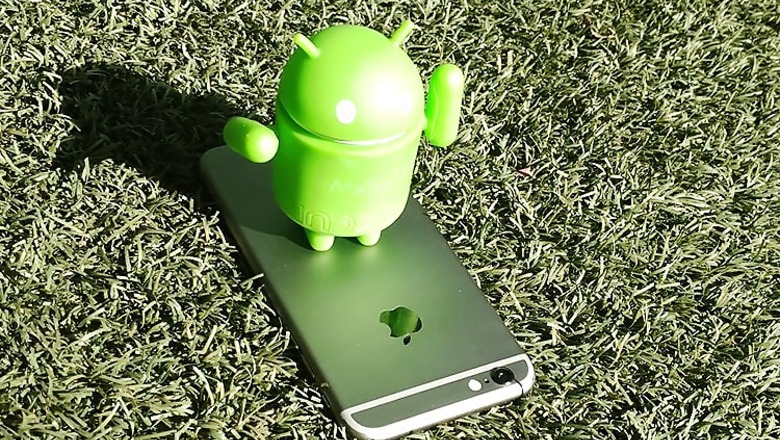
views
"If you don’t have an iPhone..." you probably have an Android phone (actually you are more likely to own an Android phone). And we give you 15 reasons to feel a little more pleased with your choice of phone.
The iPhone that revolutionised the smartphone market is now in its 9th generation with the iPhone 6s and iPhone 6s Plus. But there’s a long list of features that these top-of-the-line phones don’t possess that many much-humbler Android devices do.
1. Universal charging interface: The scene of an iPhone user frantically asking around for a compatible charger is reminiscent of the Nokia ‘thin-pin days.’ The absence of a standard charging interface (supported by other platforms) can make iPhone users feel incapacitated at times when their phones run low on battery. The iPhone charging woes doesn’t end at that. The connector used in older iPhones 4/4s were different from the ones used in iPhone 5 and above.
For an Android user, life is much simpler. With most Android phones being equipped with a charging interface that is more or less an industry standard, there is not much trouble in finding that friendly charger.
The next move to USB Type-C is already on. Apple has included it in the new MacBook but will it be included in the next iPhone?
2. USB OTG (on-the-go): With a limited storage space on most phones, it's not always possible for you to store everything that you need on your device. And that is when the OTG capability on Android phones (not a standard feature, but available on many phones) comes to the rescue. The OTG feature on phones allows you to simply connect a pen drive to your phone (via an OTG cable) and voila! Some pen drives even come with built-in OTG support. But if you are an iPhone user, this isn’t as easy and as readily available as for Android devices.
3. Wireless charging: While it's a high-end feature and is currently available only in a few flagship Android phones, but not yet in any of the iPhones.
4. Dual-SIM support: I personally know a couple of users who moved from iPhone to Android merely because of the absence of the dual-SIM support in iPhones. This might not be so desirable a feature in Apple’s home market but in countries such as India, having two SIMs is often a necessity and this is becoming more of a norm for Android phones rather than an exception.
5. Expandable storage: There have been security and performance concerns about the inclusion of additional storage (via a microSD card) in a phone. And therefore, you will see companies taking different stands on this. While Apple has been sticking to its old idea of not offering an option to expand storage memory, the Android market is fragmented in this context. While majority of OEMs like Samsung, LG and Sony are of the opinion to have a microSD card slot in phones, others like Google, which has its OS running on all Android devices doesn't prefer to offer additional storage on its Nexus devices. Xiaomi, on the other hand, has a mix of both (expandable and non-expandable models) in its Android product portfolio.
Despite this, most Android users have an option to make a choice if they want phones with additional storage or remain comfortable with only built-in memory. On other hand, iPhone users need to just manage with the limited storage available on their phones. Even though iPhones come in different storage variants they are accompanied with deterring price tags.
6. Guest mode: The Guest mode introduced by Google in Android 5.0 has proven to be a boon for many, especially for parents who share their phones with their kids. The availability of setting up a Guest mode on Android phones not only keeps your data safe and away from the reach of others, but also makes it easier for users to share their Android device with other family members. iPhones don’t have a comparable feature to offer.
7. In-call recording: There are times, when you need to record conversations taking place over the phone for legitimate purposes. And as a journalist who often needs to record telephonic interviews, I can understand the significance of having an in-call recording feature in a phone. While the feature is not available in all Android phones, there are many handsets that come with this feature on board. For instance, phones from Asus and Xiaomi come pre-loaded with the in-call recording support. But if you have an iPhone, you would need to get additional stuff to be able to do that or resort to such jugaads:
An iPhone-owning colleague had to record a telephonic interview but he, obviously, couldn’t do that on his phone. So found a quiet corner in the office, made the call via a landline phone, put it on speaker mode and used the voice recorder on iPhone to record the conversation.
8. Lock-screen gestures: While Android phones come with a plethora of options to unlock your phone including a fingerprint sensor, PIN, password, swipe, pattern, and face detection, iPhones, on the other hand, include only two - passcode and TouchID fingerprint.
9. Quick charging: Be it Motorola's Turbo charging feature or the rapid charging via USB Type-C in the new Nexus phones, there are many Android phones out there that support fast charging. For instance, the TurboPower charger gives the Moto X Style users over 6 hours of power in just 15 minutes.
While Apple boasts of improved battery in the new iPhones, it still doesn't have support for quick charging.
10. Drag and drop files: The ease with which data can be transferred to Android phones is missing in iPhones. Android users need to just simply connect the phone to a laptop/desktop, select the files, drag and drop. iPhone users, however, can transfer files to their iPhones only if the device the content is being transferred from has iTunes pre-installed. The seamless Android file transfer experience is missing for iPhone users who are often tied to a single PC to sync their content.
11. Multiple apps on one screen: The multi-window mode splits your phone's screen in different parts so that users can access multiple apps on one screen, thereby bringing desktop-like capabilities to the phone. While this mode is limited to a very few Android handsets, primarily Samsung's, you can’t do that on an iPhone - not even on the 6s Plus.
12. Universal remote control: IR blaster in Android phones allows users to double their phone as universal remote control for devices used at home including TV and AC. Though all Android phones don't come with IR blasters, there are many from companies including Samsung, HTC, ZTE, Oppo, and LG that come engineered with it. No such comforts for iPhone users.
13. FM Radio: FM Radio is one of the key features that many phone users in India look forward to while buying a new device. And this is the reason that many companies are including FM radio in their devices released for the Indian market. For instance, OnePlus, keeping in mind the nature of the Indian market, recently announced the OnePlus Radio that debuted with the OnePlus X. But this app that is almost a necessity for millions of users isn’t there on any iPhone.
14. Sharing via Bluetooth: One of the oldest ways to share files is via Bluetooth. While in the modern-age world, people prefer IM apps like WhatsApp, sharing apps like ShareIT, or cloud services like DropBox for file sharing, but it is always handy to have Bluetooth around in times of patchy connectivity or limited data. But if you have an iPhone, you might want to venture out looking for a stronger signal (or change your data plan).
15. Default browser: The Internet is about freedom and one of the primary freedoms is the choice of a Web browser. But if you are an iPhone user Apple will not allow you that liberty. While you can install other browsers on an iPhone, Safari will remain the default unless you take routes that Apple doesn’t want you to (such as jailbreaking). For Android users, changing the default browser is only a tap away.


















![Kia Sonet Compact SUV to Launch in India Today: Watch it Live Here [Video]](https://cdn.rawisda.com/news/90/eb/76/90eb7699f91f82cb9d217ba52d313a8a-s.jpg)
Comments
0 comment